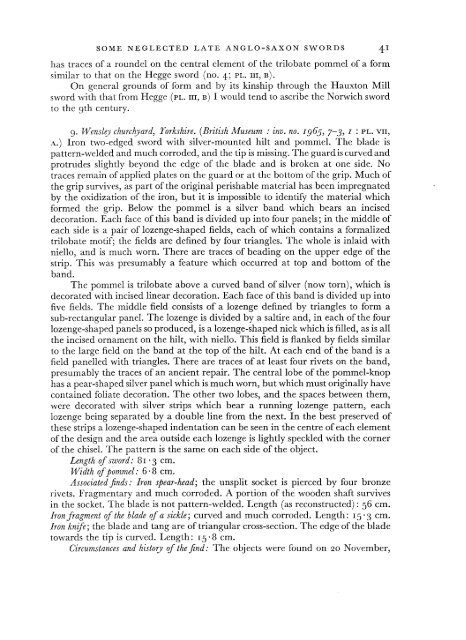Some Neglected Late Anglo-Saxon Swords - Archaeology Data ...
Some Neglected Late Anglo-Saxon Swords - Archaeology Data ...
Some Neglected Late Anglo-Saxon Swords - Archaeology Data ...
Create successful ePaper yourself
Turn your PDF publications into a flip-book with our unique Google optimized e-Paper software.
SOME NEGLECTED LATE ANGLO-SAXON SWORDS 41<br />
has traces of a roundel on the central clement of the trilobate pommel of a form<br />
similar to that on the Hegge sword (no. 4; PL. III, B).<br />
On general grounds of form and by its kinship through the Hauxton Mill<br />
sword with that from Hegge (PL. III, B) I would tend to ascribe the Norwich sword<br />
to the gth century.<br />
g. Wensll!Y churchyard, Yorkshire. (British Museum: inv. no. 1965, 7-3, 1 : PL. VII,<br />
A.) Iron two-edged sword with silver-mounted hilt and pommel. The blade is<br />
pattern-welded and much corroded, and the tip is missing. The guardis curved and<br />
protrudes slightly beyond the edge of the blade and is broken at one side. No<br />
traces remain ofapplied plates on the guard or at the bottom ofthe grip. Much of<br />
the grip survives, as part of the original perishable material has been impregnated<br />
by the oxidization of the iron, but it is impossible to identify the material which<br />
formed the grip. Below the pommel is a silver band which bears an incised<br />
decoration. Each face of this band is divided up into four panels; in the middle of<br />
each side is a pair of lozenge-shaped fields, each of which contains a formalized<br />
trilobate motif; the fields are defined by four triangles. The whole is inlaid with<br />
niello, and is much worn. There are traces of beading on the upper edge of the<br />
strip. This was presumably a feature which occurred at top and bottom of the<br />
band.<br />
The pommel is trilobate above a curved band of silver (now torn), which is<br />
decorated with incised linear decoration. Each face of this band is divided up into<br />
five fields. The middle field consists of a lozenge defined by triangles to form a<br />
sub-rectangular panel. The lozenge is divided by a saltire and, in each of the four<br />
lozenge-shaped panels so produced, is a lozenge-shaped nick which is filled, as is all<br />
the incised ornament on the hilt, with niello. This field is flanked by fields similar<br />
to the large field on the band at the top of the hilt. At each end of the band is a<br />
field panelled with triangles. There are traces of at least four rivets on the band,<br />
presumably the traces of an ancient repair. The central lobe of the pommel-knop<br />
has a pear-shaped silver panel which is much worn, but which must originally have<br />
contained foliate decoration. The other two lobes, and the spaces between them,<br />
were decorated with silver strips which bear a running lozenge pattern, each<br />
lozenge being separated by a double line from the next. In the best preserved of<br />
these strips a lozenge-shaped indentation can be seen in the centre ofeach element<br />
of the design and the area outside each lozenge is lightly speckled with the corner<br />
of the chisel. The pattern is the same on each side of the object.<br />
Length ofsword: 8 I . 3 ern.<br />
Width ifpommel: 6·8 em.<br />
Associated finds: Iron spear-head; the unsplit socket is pierced by four bronze<br />
rivets. Fragmentary and much corroded. A portion of the wooden shaft survives<br />
in the socket. The blade is not pattern-welded. Length (as reconstructed) : 56 em.<br />
Ironfragment if the blade ifa sickle; curved and much corroded. Length: 15'3 em.<br />
Iron knife; the blade and tang are oftriangular cross-section. The edge ofthe blade<br />
towards the tip is curved. Length: 15.8 em.<br />
Circumstances and history if thefind: The objects were found on 20 November,

















